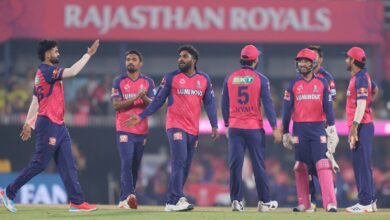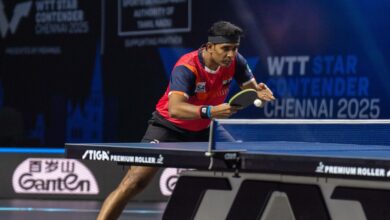How will Smith and Labuschagne bat against Ashwin and Co.? S Sriram, Australia’s former assant coach explains

Seconds matter when you play in India. In the end, our preparation for the 2017 series in India (Australia sent a scare winning the first Test on a raging turner at Pune), came down to how we managed those seconds. Let me explain.
In Australia the batsmen are used to playing pace bowling and you get around 20-25 seconds between each delivery. The time the ball moves from fielder or the wicketkeeper eventually to the bowler who walks back to the top of his long run up. But here in India, it’s 10-15 seconds. A raging turner, spinners on top, fielders on top, crowd yelling – and a batsman has to somehow shut out all the external noise and re-focus within those precious seconds.
This is where most visiting batsmen make lots of makes because they are not ready in that span of time. They are used to taking a bit more time before each delivery. Even the elite players are used to that. Even for Steve Smith, to switch on every 10 seconds is something not natural. Ravindra Jadeja hardly has a run-up; neither does R Ashwin. They are ready to bowl the next ball in 8 seconds.
As a batsman you might have been beaten the previous ball, but you have to shrug off all that and re-focus so soon on a turner.
And the practice continues….#INDvAUS https://t.co/qwRUSxcL pic.twitter.com/5mECrOjWiG
— BCCI (@BCCI) February 3, 2023
I knew it wasn’t going to be easy but it was something we had to do. Ahead of that 2017 series, we inculcated that habit in our preparation. Don’t give too much time between deliveries as someone like Jadeja isn’t going to give you any; he finishes his over in a minute and half. So we sped up the time in our preparatory sessions. It worked up well as the batsmen got used to switching on and off mentally between each delivery.
In some ways, it was my coaching philosophy too: keep it straight forward and try to replicate what you are going to get in terms of the conditions. Tailor the strategy accordingly. Set up the environment as close to what you are going to get in real time.
I was working on and off with Australian teams from 2015 and it was that 2017 series in India when Australia won at Pune in the first Test where my relationship with them cemented. The trust kept getting better and better.
Scuffing up the pitch
In India every venue is so different in terms of the nature of soil — black, red, clay. Even with scuffing, pitches react differently: some pitches powder up, some develop troughs. We tried to cover all that as much as possible in our preparation. Sometimes we would powder up the pitch, and at times we tried to create footmarks where you get indentation.
The ball behaves differently on those indentations depending on the angle of the seam that lands on it. All these minute details matter in preparation as well. That’s why a tour of India is challenging. That’s why India have lost just 2 Tests since 2012. We tried our best to replicate the conditions; it was hard but were helped the curators in Dubai, where we had our pre-series camp.
How are the Aussies preparing for @ashwinravi99 ahead of their upcoming Test series with India? Well, they’ve only gone and flown in a near carbon copy of the star off-spinner as a net bowler | #INDvAUS pic.twitter.com/l9IPv6i43j
— cricket.com.au (@cricketcomau) February 3, 2023
Pune Test, 2017: Smith sparkles; Renshaw negates Ashwin
Steve Smith batted outstandingly well there. It was more about Smith out-batting India rather than Australia out-batting India.
However, Matthew Renshaw too played well in that Test, especially the way he played Ashwin was outstanding. Being a left-hander, scoring runs in the leg side against Ashwin is very important and batsmen who have done that against him have been successful. If you close off the leg side, he is too good a bowler. He will dominate. But if you are able to open up that leg-side area, then it makes him think a little more. And that is what Renshaw was able to do, he was able to pick singles and rotate the strike. That comes with a risk of leading edge, playing against the spin, but it is something he worked very hard at that time. And as a tall guy, he was able to use his reach, smother the turn, and do his best to get Ashwin feel frustrated. Once you get that easy single on the leg side, it forces him to take one fielder from the off-side and suddenly there is one less catching fielder. Left handers who are able to score on the leg side against Ashwin can succeed.
Smith and Labuschagne can style midway
Labuschagne is a phenomenal batsman. I genuinely feel, like Steve Smith, he has the ability to change his game in the middle of his innings. He can change his technique, his grip in the middle of the game and that is what makes both of them stand out, because they aren’t too rigid with their plans. Of course, they have their plans, but once they know it is not working, they have the ability to change it in the middle of an innings.
For example, in that series, Smith would suddenly shift from hitting with the spin to hitting against the spin. He can switch it in the middle of the innings. When it was reverse-swinging, Smith was hitting everything on the off-side. Suddenly he stopped shuffling across; instead just started shuffling back and then clearing his front foot and was hitting on the off-side. Very few have that sort of ability. You can’t be rigid and do well in India. You have to adapt.
And Labuschagne is very similar; he can change his bottom hand grip and start hitting into the spin. He can manipulate his game according to what is required on that day. I think they both hold the key for the current series because they think from their feet. For Marnus and South, it’s more about playing a long innings than taking the game away in a session or an hour.
Nagpur Test holds the key now
Nagpur will be an interesting surface because it is red soil. Depending how much grass they have left to bind the surface and underlying moure, the turn it takes will be different. At least the bounce in Nagpur will aid Australia.
In Delhi and Dharamsala, the lack of bounce will be more of a challenge. The first Test will be crucial because in a series like this, how a batsman starts determines the series. If your couple of innings don’t go well as a batsman, you start to chase the game and if you are an overseas batter if your first couple of innings don’t go well then it becomes a mental battle — whether you stick to your preparation or change the game, whether you change your tactic to a particular bowler. All these things start weighing on your mind.
Then it becomes a mind game; so the first Test will set the tone for the series. Especially for the young batsmen like Travis Head, Cameron Green, Alex Carey. The others have the experience to draw upon.
Australia is a team of two halves — top order has experience and the middle order is thin on experience. How they manage that will determine the course of the series.
India have their challenges as well. There is no Pant, no Bumrah and we don’t know how Suryakumar Yadav will go in Test cricket. Jadeja is also coming back after a long time. India come with some unknown and that is where Australia would see an opportunity. They have got a good batting line up and an all-round attack. It will be a series where one big gun will make the ultimate difference
For Australia it is one of the biggest goals to beat India in India. They last did in 2004. After that they have just one win in 2017. A series win in India is humongous for them. I know they have a deep burning desire to do well here.
(As told to Venkata Krishna B)






